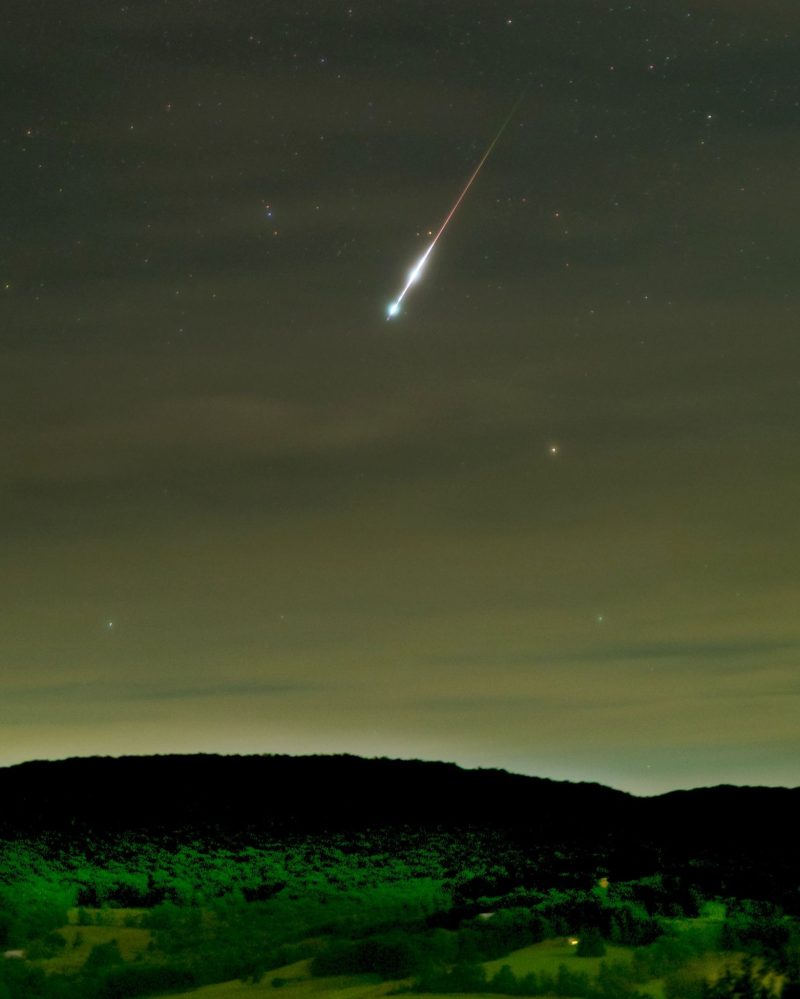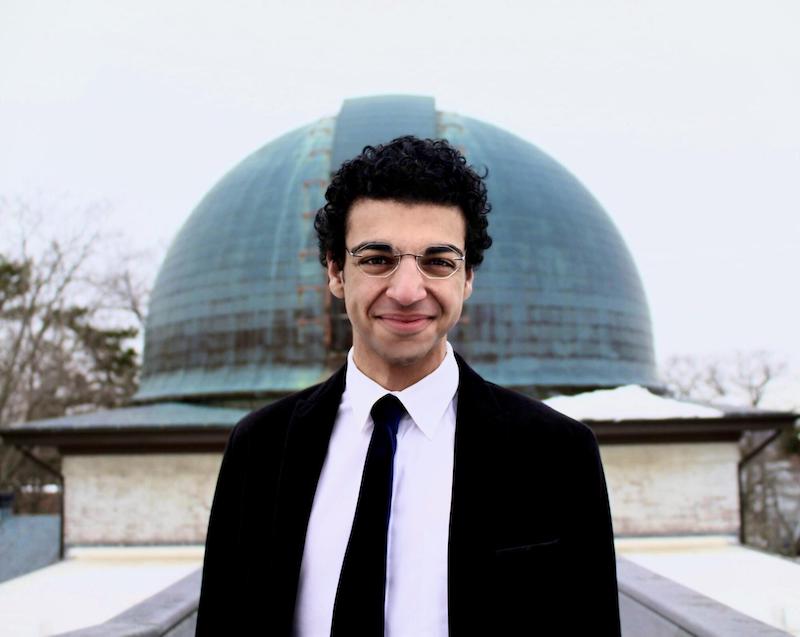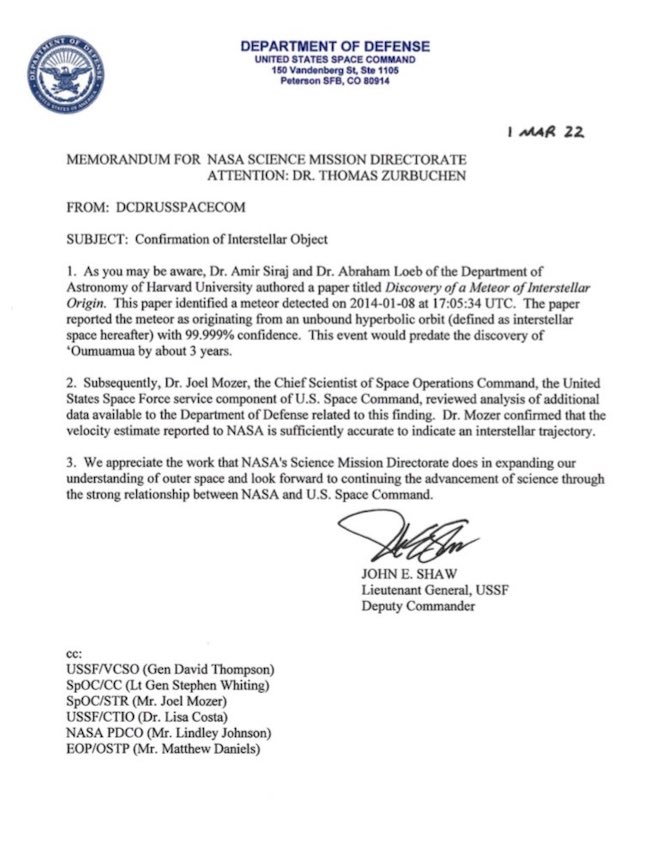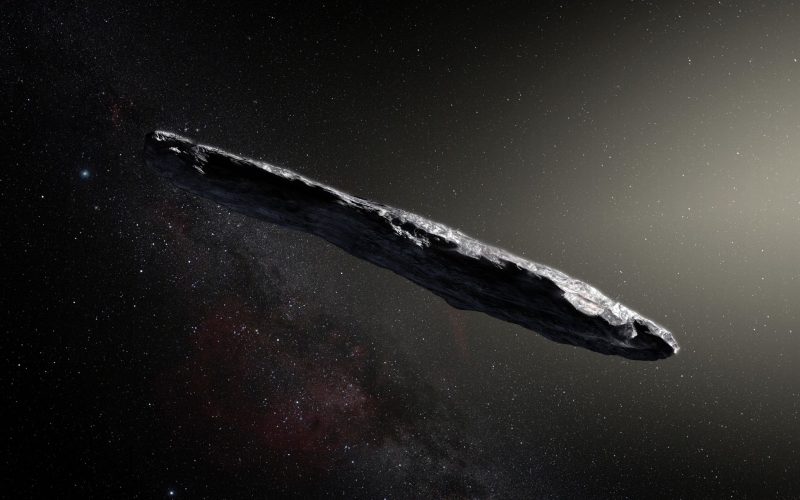
Did an interstellar meteor hit Earth in 2014?
Remember in 2017, when the first-ever-known interstellar object – first-known object from outside our solar system – passed through? ‘Oumuamua, as it was later named, became a much-debated and controversial object. Astronomers weren’t sure if it was an asteroid, comet … or what? Then, in 2019, astronomers spotted a second interstellar object. This second object looked distinctly comet-like and became known as Comet 21/Borisov. These two have been widely heralded as the 1st interstellar objects to pass through our solar system. But were they? Earlier in April 2022, the U.S. Space Command – which is responsible for military operations in outer space – confirmed in a memo that a meteorite that struck Earth in 2014 also came here from another star system.
Becky Ferreira at VICE wrote about the surprising update to this meteor story on April 4, 2022. She said the meteor:
… ignited in a fireball in the skies near Papua New Guinea, the memo states, and scientists believe it possibly sprinkled interstellar debris into the South Pacific Ocean.
Later, in 2019, two researchers from Harvard University – Amir Siraj and Avi Loeb, both of whom had published on ‘Oumuamua and Comet Borisov earlier – also wrote a study of this meteor, suggesting its interstellar origins. If true, then this meteor – which predates both ‘Oumuamua and Comet Borisov by a few years – would be the first known interstellar object. Neither ‘Oumuamua nor Comet Borisov struck the Earth, of course. Both are now on courses that will take them back to interstellar space, where we’ll more than likely never see them again.
The meteor had been the subject of a 2019 study, which had also argued for an interstellar origin. That study had been submitted to The Astrophysical Journal Letters in 2019, but has not yet been peer-reviewed.
The 2014 impact
So the memo from the U.S. Space Command (USSC) is new. But the incident itself isn’t. The meteor collided with Earth on January 8, 2014, near Manus Island in Papua New Guinea. It wasn’t all that big, just a few feet (a meter or so) across. But scientists believe it was big enough to scatter debris, which likely fell into the ocean.
Ferreira’s article in VICE quoted Siraj, who is lead author on the new paper:
I get a kick out of just thinking about the fact that we have interstellar material that was delivered to Earth, and we know where it is. One thing that I’m going to be checking – and I’m already talking to people about – is whether it is possible to search the ocean floor off the coast of Papua New Guinea and see if we can get any fragments.
Siraj is a Ph.D. student at Harvard and also the director of Interstellar Object Studies at a new organization at Harvard, called the Galileo Project. The project’s stated goal is to identify the nature of ‘Oumuamua-like interstellar objects.

Government secrecy hinders investigation
So, was this really an interstellar meteor? Siraj and his co-author Loeb at Harvard think so, but their research hit a few roadblacks in recent years. Some of the information about the event had actually been deemed classified by the government. NASA runs a database for meteors and fireballs called the Center for Near Earth Object Studies (CNEOS). However, the government withheld some of the information regarding the 2014 meteor from the database. Why?
Likely because the sensors used to detect such fireballs and meteors are the same ones used by the Department of Defense to monitor nuclear detonations. Therefore, the data is classified and not available to civilian researchers. As Ferreira wrote in VICE:
The secret data threw the paper into limbo as the researchers sought to get confirmation from the U.S. government. Siraj called the multi-year process a ‘whole saga’ as they navigated a bureaucratic labyrinth that wound its way though Los Alamos National Laboratory, NASA, and other governmental arms, before ultimately landing at the desk of Joel Mozer, Chief Scientist of Space Operations Command at the U.S. Space Force service component of USSC.
The memo
The memo from USSC was dated March 1, 2022. It stated that Mozer:
… confirmed that the velocity estimate reported to NASA is sufficiently accurate to indicate an interstellar trajectory.
USSC tweeted the news about the memo on April 6, 2022:
6/ “I had the pleasure of signing a memo with @ussfspoc’s Chief Scientist, Dr. Mozer, to confirm that a previously-detected interstellar object was indeed an interstellar object, a confirmation that assisted the broader astronomical community.” pic.twitter.com/PGlIOnCSrW
— U.S. Space Command (@US_SpaceCom) April 7, 2022
You can read the memo more easily below:

In addition, planetary scientist Pascal Lee also tweeted about the memo on April 6, 2022:
INTERSTELLAR METEOR CONFIRMED@US_SpaceCom has confirmed that a bolide event on 1/8/14, which @TheAmirSiraj & Avi Loeb identified as entry of a 0.45m object of likely interstellar origin (https://t.co/I6KIuCQQ4I), is indeed interstellar!
Must find an interstellar meteorite… pic.twitter.com/lPqcVoNJym
— Pascal Lee (@pascalleetweets) April 6, 2022
Interstellar meteor was small and fast
The meteor may have been small, but it was also traveling at an incredible speed. The researchers estimated it blazed through our atmosphere at about 130,000 miles per hour (209,000 kph) or more. As noted in the 2019 study, that suggested:
… a possible origin from the deep interior of a planetary system or a star in the thick disk of the Milky Way galaxy.
As Siraj told VICE:
It was really fast, and so I was like: ‘Oh, my God, this could be an interstellar meteor.’
Searching for debris
Siraj now wants a couple of things to happen. He wants his paper to finally be peer-reviewed and published so that follow-up research can begin. As quoted above, he would also like to see a search conducted of the ocean floor in the area where the meteor hit. The odds of finding fragments any may be low, but the scientific payoff – of having a sample of interstellar material – would be huge. As he told VICE:
It would be a big undertaking, but we’re going to look at it in extreme depth because the possibility of getting the first piece of interstellar material is exciting enough to check this very thoroughly and talk to all the world experts on ocean expeditions to recover meteorites.
Not all scientists convinced
Some scientists, however, remain unconvinced so far. As Jonathan McDowell, an astrophysicist at the Harvard-Smithsonian Center for Astrophysics, told Gizmodo:
This letter isn’t science, and I put no weight on it. ‘Reviewed the data’ isn’t showing your work. The detailed calibration and accuracy information for the infrared missile warning satellites are not available (for good reasons), and without that, there will always be a question mark on this analysis.
Others are skeptical of the fireball data itself. Alan Jackson, an astrophysicist at Arizona State University, told Gizmodo that the data:
… is very prone to errors, especially for the speed and direction information that is essential to making a claim that a meteor is interstellar in origin.
Jackson said that the data only matched another dataset, the Desert Fireball Network:
… about one third of the time.
He also said that it could be:
Dramatically wrong.
Jackson added:
It is not possible for other scientists to independently examine the raw data and confirm interstellar origin of this meteor. If the speed and direction of the meteor are correct, then it was interstellar in origin. However, we still don’t really know how accurate the speed and direction are, so the claim that the probability of it being interstellar is ‘99.999 percent’ (as stated in the Siraj and Loeb paper) is basically just numbers plucked out of the air.

We may never know for sure if it was an interstellar meteor
The researchers seem confident in their analysis, but we may never know with 100% certainty whether the 2014 meteor really was interstellar or not. Unless, of course, scientists are lucky and successfully find some of the tiny bits of debris on the ocean floor that can be analyzed. But there could be more in the future, also. As Siraj noted in VICE:
But the fact of the matter is, going forward, we won’t find anything unless we look for it. We might as well take it upon ourselves as scientists to build a network as extensive as the U.S. government’s sensor network, and use it for the purposes of science and fully use the atmosphere. The atmosphere is already a sensor for these things. We’re just not paying attention to the signals. So we might as well use the whole atmosphere and see what comes our way.

Bottom line: The U.S. Space Command (USSC) published a surprising memo last week stating that an interstellar meteor crashed near Papua New Guinea in 2014. The meteor was the subject of a study in 2019 that reached the same conclusion, but some of the satellite data used was data that the USSC kept classified.
Source (preprint): Discovery of a Meteor of Interstellar Origin











